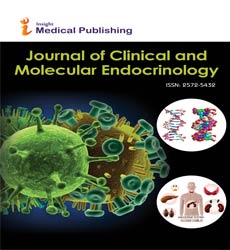Gut Microbiome and Endocrine Crosstalk: Molecular Pathways and Clinical Implications
Alexandra Javier
Department of Health Sciences, European University of Madrid, Madrid, Spain
Published Date: 2025-02-28DOI10.36648/2572-5432/10.1.003
Corresponding author:
Alexandra Javier,
Department of Health Sciences, European University of Madrid, Madrid, Spain,
E-mail: Javier.alex@helth.edu
Received Date: February 01, 2025, Manuscript No. ipjcme-25-20471; Editor assigned date: February 03, 2025, PreQC No. ipjcme-25-20471 (PQ); Reviewed date: February 14, 2025, QC No. ipjcme-25-20471; Revised date: February 21, 2025, Manuscript No. ipjcme-25-20471 (R); Published date: February 28, 2025, DOI: 10.36648/2572-5432/10.1.003
Citation: Javier A (2025) Gut Microbiome and Endocrine Crosstalk: Molecular Pathways and Clinical Implications. J Clin Mol Endocrinol Vol: 10 No 1:3.
Introduction
The gut microbiome, a diverse community of microorganisms inhabiting the gastrointestinal tract, is increasingly recognized as a crucial regulator of human health. Beyond its role in digestion and nutrient absorption, the microbiome influences host immunity, metabolism, and endocrine function. Recent studies highlight a bidirectional crosstalk between gut microbes and the endocrine system, mediated by microbial metabolites, host signaling pathways, and hormonal feedback loops. This intricate interaction has profound implications for metabolic regulation, reproductive health, stress response, and endocrine-related diseases [1].
Description
One of the central molecular pathways linking the gut microbiome and endocrine system involves microbial metabolites such as short-chain fatty acids (SCFAs), bile acids, and tryptophan-derived indoles. SCFAs, produced by the fermentation of dietary fibers, regulate glucose and lipid metabolism through activation of G-proteinâ??coupled receptors and modulation of insulin secretion. Similarly, gut microbes transform bile acids, which then act on farnesoid X receptor (FXR) and TGR5, influencing glucose homeostasis and energy expenditure. These pathways demonstrate how microbial metabolites serve as endocrine-like signals, directly shaping host hormonal balance and metabolic outcomes [2].
The hypothalamic-pituitary-adrenal (HPA) axis also interacts with the gut microbiome. Stress-induced cortisol release alters gut permeability and microbial composition, while gut microbes regulate stress response by modulating neurotransmitters such as serotonin and Gamma-Aminobutyric Acid (GABA). Dysbiosis has been associated with exaggerated HPA activity, linking altered microbiota to mood disorders, obesity, and metabolic syndrome. This reciprocal regulation highlights the gut-brain-endocrine axis as a critical interface where microbial signals and hormonal pathways converge to affect systemic health [3].
Reproductive endocrinology is another domain where microbiome-endocrine crosstalk plays a vital role. The gut microbiome influences estrogen metabolism through the "estrobolome," a collection of microbial genes encoding enzymes that deconjugate estrogens, thereby modulating circulating hormone levels. Dysregulation of this system has been implicated in conditions such as polycystic ovary syndrome (PCOS), endometriosis, and infertility. In men, alterations in gut microbial composition have been linked to testosterone metabolism and reproductive function. These findings underscore the microbiomeâ??s role as a regulator of reproductive health via endocrine mechanisms [4].
Clinical implications of microbiome-endocrine interactions extend to metabolic and endocrine disorders, including type 2 diabetes, obesity, thyroid dysfunction, and adrenal disorders. For instance, altered gut microbial profiles are consistently observed in patients with insulin resistance and obesity, suggesting a pathogenic role. Interventions such as probiotics, prebiotics, dietary modification, and Fecal Microbiota Transplantation (FMT) are being investigated as therapeutic strategies to restore microbiome balance and improve endocrine function. The integration of microbiome-targeted therapies into endocrinology could provide novel approaches for personalized medicine [5].
Conclusion
The crosstalk between the gut microbiome and endocrine system represents a dynamic and complex network of molecular pathways with far-reaching clinical consequences. Microbial metabolites, hormonal signaling, and host-microbiome interactions converge to regulate metabolic, reproductive, and stress-related endocrine functions. As research advances, microbiome modulation may become a cornerstone of therapeutic strategies for endocrine and metabolic diseases. Understanding this interplay not only deepens our knowledge of human physiology but also opens new frontiers for clinical interventions aimed at improving overall health.
Acknowledgement
None.
Conflict of Interest
None.
References
- Yang T, Santisteban MM, Rodriguez V, Li E, Ahmari N, et al. (2015). Gut dysbiosis is linked to hypertension. Hypertension 65: 1331-1340.
Google Scholar Cross Ref Indexed at
- Pires L, González-Paramás AM, Heleno SA, Calhelha RC (2024). The role of gut microbiota in the etiopathogenesis of multiple chronic diseases. Antibiotics 13: 392.
Google Scholar Cross Ref Indexed at
- Hills RD, Pontefract BA, Mishcon HR, Black CA, Sutton SC, et al. (2019). Gut microbiome: Profound implications for diet and disease. Nutrients, 11: 1613.
Google Scholar Cross Ref Indexed at
- Cani PD (2018). Human gut microbiome: Hopes, threats and promises. Gut 67: 1716-1725.
Google Scholar Cross Ref Indexed at
- Forbes JD, Chen CY, Knox NC, Marrie RA, El-Gabalawy H, et al. (2018). A comparative study of the gut microbiota in immune-mediated inflammatory diseases—does a common dysbiosis exist?. Microbiome 6: 221.
Open Access Journals
- Aquaculture & Veterinary Science
- Chemistry & Chemical Sciences
- Clinical Sciences
- Engineering
- General Science
- Genetics & Molecular Biology
- Health Care & Nursing
- Immunology & Microbiology
- Materials Science
- Mathematics & Physics
- Medical Sciences
- Neurology & Psychiatry
- Oncology & Cancer Science
- Pharmaceutical Sciences
